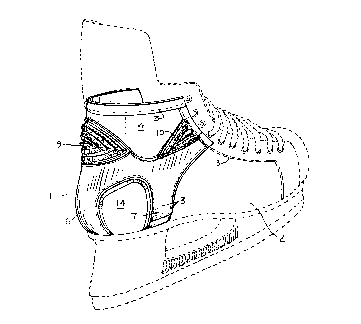Some of the information on this Web page has been provided by external sources. The Government of Canada is not responsible for the accuracy, reliability or currency of the information supplied by external sources. Users wishing to rely upon this information should consult directly with the source of the information. Content provided by external sources is not subject to official languages, privacy and accessibility requirements.
Any discrepancies in the text and image of the Claims and Abstract are due to differing posting times. Text of the Claims and Abstract are posted:
| (12) Patent: | (11) CA 2084829 |
|---|---|
| (54) English Title: | SKATE BOOT WITH MOULDED PLASTIC OVERLAY |
| (54) French Title: | CHAUSSURE DE PATIN MUNIE D'UN RECOUVREMENT EN PLASTIQUE MOULE |
| Status: | Expired and beyond the Period of Reversal |
| (51) International Patent Classification (IPC): |
|
|---|---|
| (72) Inventors : |
|
| (73) Owners : |
|
| (71) Applicants : |
|
| (74) Agent: | SMART & BIGGAR LP |
| (74) Associate agent: | |
| (45) Issued: | 1999-04-20 |
| (22) Filed Date: | 1992-12-08 |
| (41) Open to Public Inspection: | 1994-06-09 |
| Examination requested: | 1992-12-08 |
| Availability of licence: | N/A |
| Dedicated to the Public: | N/A |
| (25) Language of filing: | English |
| Patent Cooperation Treaty (PCT): | No |
|---|
| (30) Application Priority Data: | None |
|---|
A skate boot is described, having a plastic overlay
sewn or otherwise secured to the boot of the skate, wrapping
around the heel of the boot from the medial to the lateral
side of the ankle. The overlay increases the rigidity of the
rear of the skate, to restrict pronation and supination, while
adding impact resistance. Preferably, in order to permit
dorsal and plantar flexion, the plastic overlay has several
cut-out areas which allow for a controlled amount of flexion
about a lateral axis, namely a heel flex cut-out area and side
flex cut-out areas on either side in the instep area.
Flexible inserts are preferably installed in the cut-out
areas, to maintain extra impact protection while permitting
flexion.
Cette invention concerne une chaussure de patin dont la tige comporte un revêtement en plastique cousu ou autrement maintenu en place autour du talon et allant de la partie médiane à la partie latérale de la cheville. Ce revêtement accroît la rigidité de l'arrière de la chaussure pour limiter les mouvements de pronation et de supination tout en offrant une protection supérieure contre les chocs. De préférence, le revêtement comporte plusieurs découpures destinées à permettre la flexion dorsale et la flexion plantaire du pied en autorisant une flexion limitée autour d'un axe transversal. Il s'agit notamment d'une découpure au talon et de découpures latérales de chaque côté du cou-de-pied. De préférence, des inserts élastiques sont posés dans les découpures pour assurer une meilleure protection contre les chocs sans restreindre les mouvements de flexion.
Note: Claims are shown in the official language in which they were submitted.
Note: Descriptions are shown in the official language in which they were submitted.

2024-08-01:As part of the Next Generation Patents (NGP) transition, the Canadian Patents Database (CPD) now contains a more detailed Event History, which replicates the Event Log of our new back-office solution.
Please note that "Inactive:" events refers to events no longer in use in our new back-office solution.
For a clearer understanding of the status of the application/patent presented on this page, the site Disclaimer , as well as the definitions for Patent , Event History , Maintenance Fee and Payment History should be consulted.
| Description | Date |
|---|---|
| Time Limit for Reversal Expired | 2002-12-09 |
| Letter Sent | 2001-12-10 |
| Grant by Issuance | 1999-04-20 |
| Inactive: Final fee received | 1998-12-02 |
| Pre-grant | 1998-12-02 |
| Inactive: Single transfer | 1998-12-02 |
| Notice of Allowance is Issued | 1998-06-09 |
| Notice of Allowance is Issued | 1998-06-09 |
| Letter Sent | 1998-06-09 |
| Inactive: Application prosecuted on TS as of Log entry date | 1998-06-04 |
| Inactive: Status info is complete as of Log entry date | 1998-06-04 |
| Inactive: First IPC assigned | 1998-05-02 |
| Inactive: IPC removed | 1998-05-02 |
| Inactive: IPC assigned | 1998-05-02 |
| Inactive: Approved for allowance (AFA) | 1998-04-30 |
| Application Published (Open to Public Inspection) | 1994-06-09 |
| Request for Examination Requirements Determined Compliant | 1992-12-08 |
| All Requirements for Examination Determined Compliant | 1992-12-08 |
There is no abandonment history.
The last payment was received on 1998-11-27
Note : If the full payment has not been received on or before the date indicated, a further fee may be required which may be one of the following
Please refer to the CIPO Patent Fees web page to see all current fee amounts.
| Fee Type | Anniversary Year | Due Date | Paid Date |
|---|---|---|---|
| MF (application, 5th anniv.) - standard | 05 | 1997-12-08 | 1997-10-17 |
| MF (application, 6th anniv.) - standard | 06 | 1998-12-08 | 1998-11-27 |
| Final fee - standard | 1998-12-02 | ||
| Registration of a document | 1998-12-02 | ||
| MF (patent, 7th anniv.) - standard | 1999-12-08 | 1999-11-23 | |
| MF (patent, 8th anniv.) - standard | 2000-12-08 | 2000-10-11 |
Note: Records showing the ownership history in alphabetical order.
| Current Owners on Record |
|---|
| BAUER INC. |
| Past Owners on Record |
|---|
| GERALD BLACK |
| JEFFREY J. ACHESON |
| T. BLAINE HOSHIZAKI |